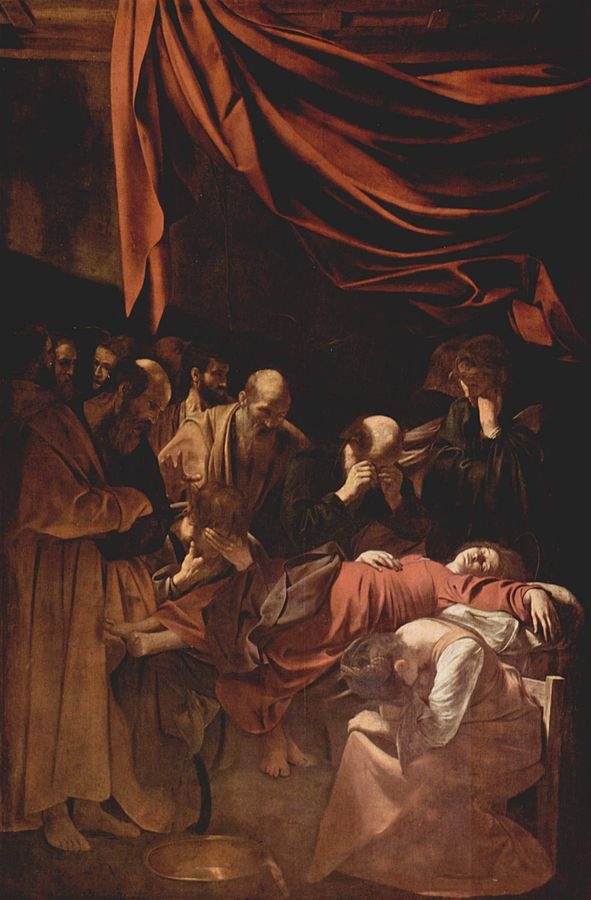Death of the Virgin
I’ve resisted choosing a Caravaggio for POTM for long enough, and after seeing this one recently at the Louvre I have had to give in! Standing in front of a painting that I have poured over in books and written about in essays was like seeing an old friend, and yet I noticed so many things that I hadn’t before.
All the action is in the bottom half of the painting, the upper part is dominated by a huge swathe of red drapery. Hanging from a coffered ceiling it cuts diagonally across the top right corner, creating a canopy over the scene below and mirroring the strong light shaft coming from the left. The heads of the figures below create another diagonal across the picture, and their zigzagged placing gives a sense of how crammed the room is. But despite the bustle the atmosphere is quiet and solemn. The room is very sparse and bleak, the rough wall at the back down and the wooden chair in the foreground are telling signs that the mother of Jesus died in an unworthy place. The colours in the picture (not clear in this image here) are quite dark and earthy, but Caravaggio uses a vibrant red to highlight things, breaking up the browns and orange with flashes of symbolic colour.
Mary is laying unceremoniously on a rickety-looking bed, her hair is a mess, her limbs hang over the edges, and the soles of her feet are on display. A hand on her stomach is perhaps a gesture of remembrance of her dead son. She wears a plain crimson dress that provides a strong contrast against her deathly pale skin. Her body is heavy and limp, the body of a mortal woman. A thin ring of gold encircles her head, but more prominent is the light that draws our eye to her face. Each of the characters in the painting are grieving in a different way; expressing concern, sadness, and disbelief. But my attention is always caught by the woman at the bottom right. Totally immersed in her mourning she sits almost separate the other figures in the painting. We can’t see her face but we can imagine what it would look like. The colours in the picture (not clear in this image here) are quite dark and earthy, but Caravaggio uses a vibrant red to highlight things, breaking up the browns and orange with flashes of symbolic colour.
The painting was commissioned by a Vatican official for his personal chapel in Santa Maria della Scala in Rome. Dedicated to a miracle-performing icon of the Virgin Mary and run by Carmelite friars, it was a sanctuary for repentant women such as prostitutes. Aside from the fact that Caravaggio did not meet the deadline for the painting, it was said that he used the body of a drowned prostitute to model the Virgin Mary. This was heretical, and the friars rejected it because of ‘its lasciviousness and lack of decorum’. Caravaggio had made a bold move to capture his vision through realism and inventiveness, but it had offended the mighty Catholic church and they sought out a more conventional artist to replace the painting. The fact that Caravaggio was not willing to sacrifice his moral and artistic integrity in order to produce something like anyone else in Rome at the time makes me admire him massively. He had a unique imagination, and this infuses all of his works with profound emotion and human understanding. Death of the Virgin depicts real life and real death. True, the woman could be anyone which the Church would have seen as irreligious, but it makes the viewer relate to its narrative, which is, as it always is with Caravaggio, the very thing which makes it so moving.

